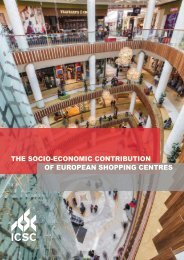THE SOCIO-ECONOMIC CONTRIBUTION OF EUROPEAN SHOPPING CENTRES
You also want an ePaper? Increase the reach of your titles
YUMPU automatically turns print PDFs into web optimized ePapers that Google loves.
Cosmetics manufacturer<br />
and retailer<br />
Avon opened its first<br />
studio store in the<br />
Zlote Tarasy shopping<br />
centre in Warsaw,<br />
Poland in January 2015.<br />
A representative for<br />
the company, which<br />
is known for moving<br />
its products via direct<br />
selling and online,<br />
said the concept of the<br />
store was ‘to create<br />
a playground for the<br />
customers, so they<br />
could touch, test and<br />
try everything in a<br />
good atmosphere.’<br />
ONLINE MOVING TO PHYSICAL LOCATIONS: With the emergence of omni-channel retailing the traditional<br />
indicators of store value have shifted. The role of the store is now multi-functional. In addition to being<br />
a point of sale, the store acts as a brand ambassador for the retailer, offering an important site for consumer<br />
engagement and face-to-face interaction. As a result, in recent years the industry has witnessed a large<br />
number of previously Internet-only retailers opening in physical locations. These stores have been well received<br />
as consumers welcome the opportunity to interact with the goods and customer service staff. Indeed,<br />
a recent consumer survey by Kantar Retail revealed that half of the respondents preferred to shop with online<br />
retailers who also operate physical stores.<br />
Even digital stalwart Google has recently ventured into the physical world, having opened its first fullybranded<br />
brick-and-mortar store inside Currys PC World on Tottenham Court Road in London’s West End in<br />
March 2015. The shop is designed to let people interact with Google’s products, such as phones and tablets,<br />
as well as bigger installations, including an interactive digital graffiti wall and a Google Earth wall. The company<br />
also hopes to run classes and events within the store, demonstrating Google’s products and educating<br />
consumers on online safety.<br />
Evidence suggests that, despite fears that opening physical stores would have a negative impact on overall<br />
costs and profitability, moving from online to offline can actually be advantageous for retailers. The fashion<br />
retailers Simply Be and Jacamo, owned by the N Brown Group, have moved from the virtual to the physical<br />
world with 16 stores in the UK. The company states that it experienced a sharp rise in sales following the<br />
opening of the stores and that the shops have not cannibalised online sales.<br />
ENHANCED TENANT MIX: As shopping centres seek to broaden their appeal as a consumer destination<br />
and not just a shopping location, the tenant mix of schemes has expanded to include a greater proportion of<br />
consumer services. Included among these non-traditional tenants are food-and-beverage (F&B) and leisure<br />
occupiers, medical and dental services, fitness and spa amenities and a wide array of educational, cultural<br />
and entertainment facilities. The incorporation of non-retail tenants into shopping centres has become an increasingly<br />
important tool for asset managers in order to enhance the visitor experience and drive dwell time.<br />
F&B operators in particular have seen a dramatic rise in recent years. An April 2014 report from the British<br />
Council of Shopping Centres (BCSC) shows that F&B tenants account for 8% of shopping centre floorspace<br />
in the UK with this figure increasing to around 15% in larger destination centres. The BCSC report also found<br />
that dwell time for those who only shopped was 99 minutes, compared with 111 minutes among those who<br />
ate. Combining both shopping and eating brought the average to 150 minutes. The research also found<br />
that while those who both ate and shopped did not spend as much time in each store as those who solely<br />
shopped, they travelled more widely across the centre.<br />
The Akbati Shopping Mall in Istanbul, Turkey exemplifies a shopping centre that has successfully<br />
incorporated a high proportion of non-retail uses alongside traditional tenants. The 65,546-sq-m centre<br />
is not only a shopping mall, but also a valuable lifestyle centre, with nine cinemas, recreation and<br />
playgrounds, a ‘Restaurants Avenue’ and Festival Park with a capacity of 5,000 for cultural activities,<br />
concerts and festivals.<br />
D. FAVOURABLE DEMOGRAPHIC TRENDS<br />
As described in the previous section, retailer demand for real estate is growing thanks to a number of varied<br />
factors. Consumer demand is also growing. The factors driving these increases bode well for the industry<br />
over both the short and long term. However, there are a number of important structural trends that are<br />
impacting the location of space and what such retail space should offer. The first is population growth and<br />
accelerating urbanism; the second is the ageing population.<br />
NET POPULATION GROWTH: According to Eurostat projections, as a whole, the total population of the 28<br />
countries that make up the European Union is expected to grow by 18.4 million individuals, or 3.6% by 2050.<br />
Of course, this growth rate differs significantly by country. For example, the UK is projected to increase its to-<br />
11



